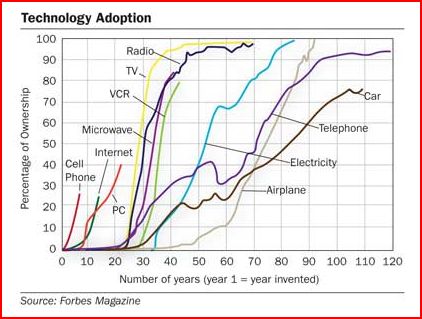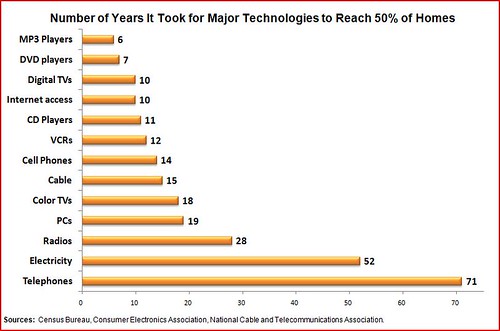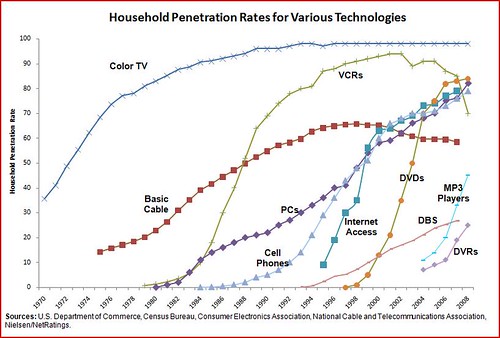Via Kevin Kelly I see that at some point Forbes magazine produced this chart measuring technology diffusion rates for various media and communications technologies since their year of inception.

I found this of great interest because, since the mid-90s, I have been putting together various charts and tables illustrating technological diffusion [most recently I did this in my "Media Metrics" report] and this particular chart is quite challenging since you are forced to pick a "Year 1" date to begin each of the "S curves." For example, what is "Year 1" for electricity or telephony on one hand, or the PC or the Internet on the other? That's not always easy to determine since it is unclear when certain technologies were "born."
Regardless, no matter how you cut it, the more modern and the less regulated the technologies, the quicker they get to market. Here's a couple of my recent charts illustrating that fact. The first shows how long it took before various technologies reached 50% household penetration. The second illustrates the extent of household diffusion over time.


However, as Kevin Kelly notes, we usually never see any technology hit 100% household penetration (although the boob tube got close!):
The rate of diffusion is accelerating. A straight line extrapolation would suggest that the rate of technological adoption should continue to accelerate until it occurs instantaneously. By the year 2100, a personal teleporter, say, should be adopted by everyone alive the year it is introduced. A new immersive VR suit the day after it is released. And a new wireless wearable communicator the hour after it is invented.
However that scenario is unlikely to happen because technology specializes as fast as it becomes common, so most technology will not be adopted by most people. In fact the more complex the technology, the less likely it will reach near-ubiquity. The peak global penetration for the average technological innovation will drop over time. We can see a hint of that in the chart above. The level of peak penetration at which diffusion plateaus is falling over time. Any particular new species of communication device in the next century is unlikely to every reach the same ubiquity as machine-woven cotton cloth, or even the television.
One final point: Defining each category is getting increasingly difficult. What is "a color TV" today? Laptops and personal computers (PCs) are currently not counted as "color TVs" by the Consumer Electronics Association or the FCC, and yet millions of people are now watching TV on their PCs. But wait, what's PC?! That too is becoming far more difficult to define. In sum, an age of convergence mucks up the measurement of such things.
Oh well, the good news is, we're getting a lot more gadgets delivered to us faster than ever before! God bless capitalism. posted by Adam Thierer @ 8:47 PM |
General
, Generic Rant
, Innovation
, Mass Media
Link to this Entry | Printer-Friendly
|
